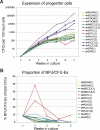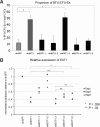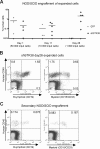Forward RNAi screens in primary human hematopoietic stem/progenitor cells
- PMID: 19188664
- PMCID: PMC2670788
- DOI: 10.1182/blood-2008-10-176396
Forward RNAi screens in primary human hematopoietic stem/progenitor cells
Abstract
The mechanisms regulating key fate decisions such as self-renewal and differentiation in hematopoietic stem and progenitor cells (HSPC) remain poorly understood. We report here a screening strategy developed to assess modulators of human hematopoiesis using a lentiviral short hairpin RNA (shRNA) library transduced into cord blood-derived stem/progenitor cells. To screen for modifiers of self-renewal/differentiation, we used the limited persistence of HSPCs under ex vivo culture conditions as a baseline for functional selection of shRNAs conferring enhanced maintenance or expansion of the stem/progenitor potential. This approach enables complex, pooled screens in large numbers of cells. Functional selection identified novel specific gene targets (exostoses 1) or shRNA constructs capable of altering human hematopoietic progenitor differentiation or stem cell expansion, respectively, thereby demonstrating the potential of this forward screening approach in primary human stem cell populations.
Figures





Similar articles
-
Forward RNAi Screens in Human Hematopoietic Stem Cells.Methods Mol Biol. 2017;1622:29-50. doi: 10.1007/978-1-4939-7108-4_3. Methods Mol Biol. 2017. PMID: 28674799
-
Inhibition of GM-CSF receptor function by stable RNA interference in a NOD/SCID mouse hematopoietic stem cell transplantation model.Oligonucleotides. 2003;13(5):353-63. doi: 10.1089/154545703322617032. Oligonucleotides. 2003. PMID: 15000826
-
Expansion of human and murine hematopoietic stem and progenitor cells ex vivo without genetic modification using MYC and Bcl-2 fusion proteins.PLoS One. 2014 Aug 29;9(8):e105525. doi: 10.1371/journal.pone.0105525. eCollection 2014. PLoS One. 2014. PMID: 25170611 Free PMC article.
-
Advances in umbilical cord blood stem cell expansion and clinical translation.Exp Hematol. 2015 Jul;43(7):498-513. doi: 10.1016/j.exphem.2015.04.011. Epub 2015 May 10. Exp Hematol. 2015. PMID: 25970610 Review.
-
Ex vivo expansion of human hematopoietic stem and progenitor cells.Blood. 2011 Jun 9;117(23):6083-90. doi: 10.1182/blood-2011-01-283606. Epub 2011 Mar 23. Blood. 2011. PMID: 21436068 Free PMC article. Review.
Cited by
-
Functional screen identifies regulators of murine hematopoietic stem cell repopulation.J Exp Med. 2016 Mar 7;213(3):433-49. doi: 10.1084/jem.20150806. Epub 2016 Feb 15. J Exp Med. 2016. PMID: 26880577 Free PMC article.
-
Oxygen-dependent Regulation of Erythropoietin Receptor Turnover and Signaling.J Biol Chem. 2016 Apr 1;291(14):7357-72. doi: 10.1074/jbc.M115.694562. Epub 2016 Feb 4. J Biol Chem. 2016. PMID: 26846855 Free PMC article.
-
Deeply dissecting stemness: making sense to non-coding RNAs in stem cells.Stem Cell Rev Rep. 2012 Mar;8(1):78-86. doi: 10.1007/s12015-011-9294-y. Stem Cell Rev Rep. 2012. PMID: 21706141 Review.
-
Genome-wide RNAi Screen Identifies Cohesin Genes as Modifiers of Renewal and Differentiation in Human HSCs.Cell Rep. 2016 Mar 29;14(12):2988-3000. doi: 10.1016/j.celrep.2016.02.082. Epub 2016 Mar 17. Cell Rep. 2016. PMID: 26997282 Free PMC article.
-
Genomic screening with RNAi: results and challenges.Annu Rev Biochem. 2010;79:37-64. doi: 10.1146/annurev-biochem-060408-092949. Annu Rev Biochem. 2010. PMID: 20367032 Free PMC article. Review.
References
-
- Sorrentino BP. Clinical strategies for expansion of haematopoietic stem cells. Nat Rev Immunol. 2004;4:878–888. - PubMed
-
- Berns K, Hijmans EM, Mullenders J, et al. A large-scale RNAi screen in human cells identifies new components of the p53 pathway. Nature. 2004;428:431–437. - PubMed
-
- Kolfschoten IG, van Leeuwen B, Berns K, et al. A genetic screen identifies PITX1 as a suppressor of RAS activity and tumorigenicity. Cell. 2005;121:849–858. - PubMed
-
- Moffat J, Grueneberg DA, Yang X, et al. A lentiviral RNAi library for human and mouse genes applied to an arrayed viral high-content screen. Cell. 2006;124:1283–1298. - PubMed
-
- Paddison PJ, Silva JM, Conklin DS, et al. A resource for large-scale RNA-interference-based screens in mammals. Nature. 2004;428:427–431. - PubMed
Publication types
MeSH terms
Substances
Grants and funding
LinkOut - more resources
Full Text Sources
Other Literature Sources
Medical

